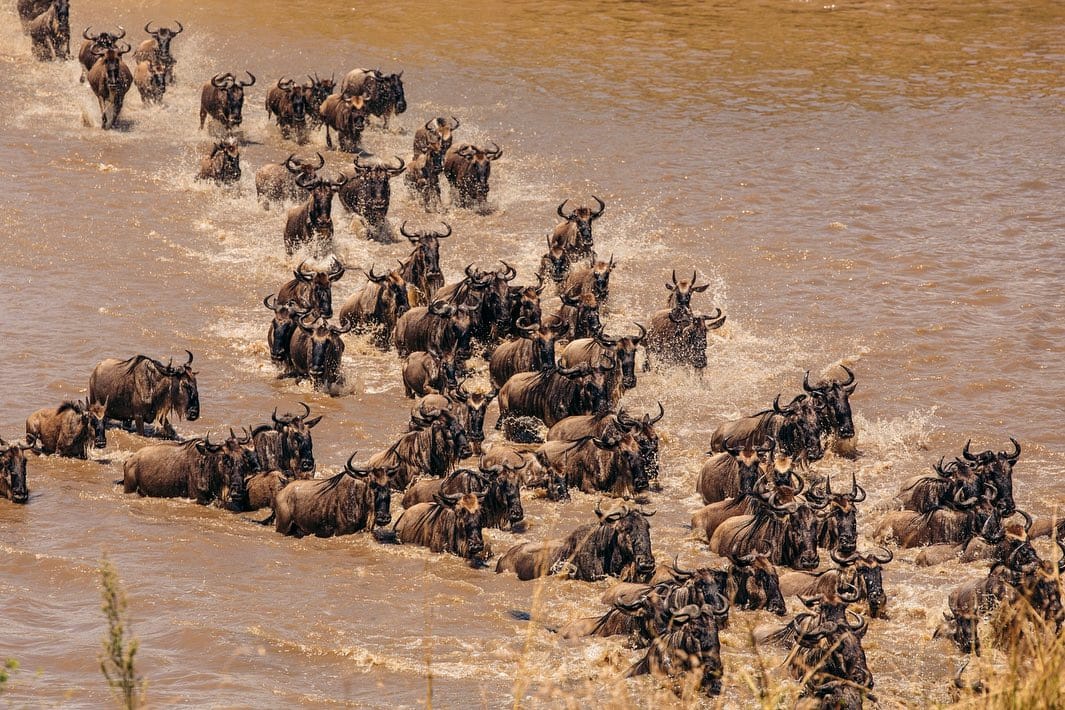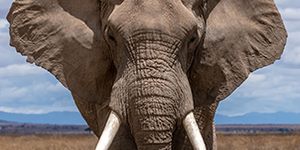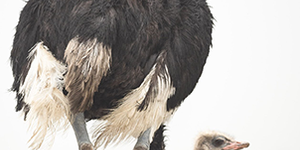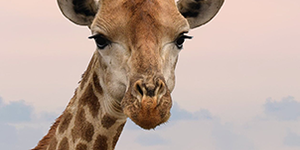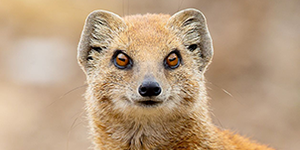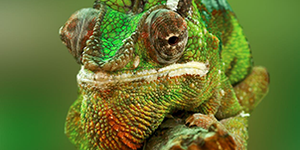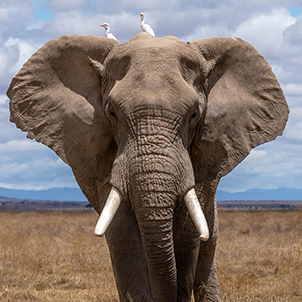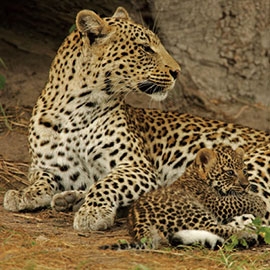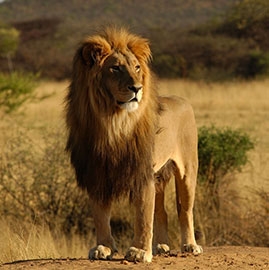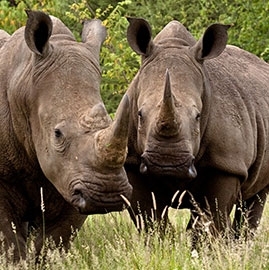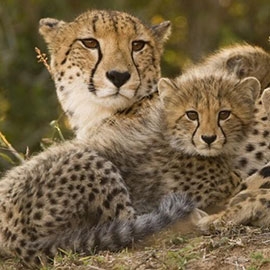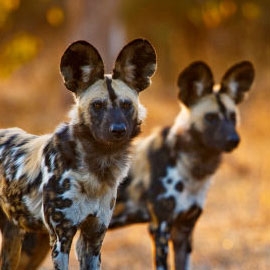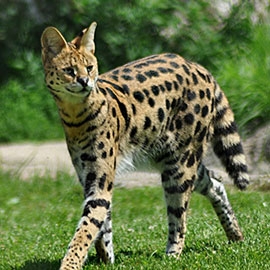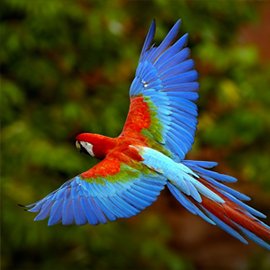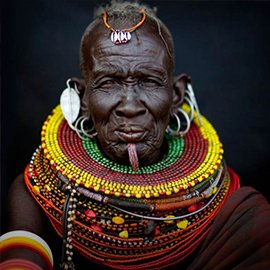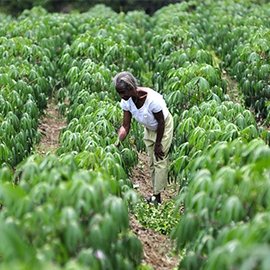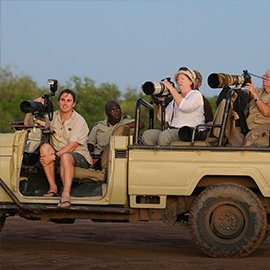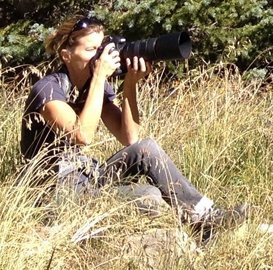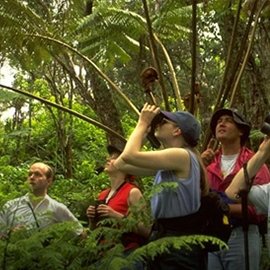Ngorongoro Crater Conservation Area
Safari suitability: 9/10
Find your tourThe park has all of the big five, but its small, limited size means that one or two days will suffice.
What YAS members think
Highlights
- Black-maned lions
- All of the big five
- No giraffe on the crater floor
- UNESCO World Heritage Site
- Proximity to other great parks, such as the Serengeti and Lake Manyara.
About Ngorongoro Crater Conservation Area
Ngorongoro Crater was originally part of the Serengeti National Park, until it became its own park in 1959. In 1979 it was declared a UNESCO World Heritage Site, is one of the most-visited regions of Tanzania and is often referred to as the eighth wonder of the world. The crater is actually the world’s largest intact caldera, with the walls of the crater being roughly 670m (2000ft) high and the crater floor measuring roughly 18km (10 miles) in diameter. The crater floor has its own ecosystem and environment and it is not uncommon for the temperature to be significantly warmer on the crater floor than it is at the rim of the crater. The elevation of the rim is around 2280m (7500ft) and the base is around 1680m (5500ft).
Because the crater floor is small in size, it can also become very crowded with vehicles. The high concentration of safari vehicles on the crater floor means the animals are more accustomed to seeing these vehicles and are less timid when they approach. This may make for better photo opportunities but it also can be a bit of a negative point for those looking for a more authentic safari experience.
There are no lodging options on the crater floor and all guests must overnight on the rim. In general, the standard of accommodation is extremely high, with five-star lodges overlooking the caldera. A Ngorongoro Crater safari is recommended for all levels of safari goers and it is a great addition to a Serengeti safari. It is also close to Tarangire and Lake Manyara National Parks.
Ngorongoro Crater wildlife
Between the crater rim and floor it is possible to see all of the big five at Ngorongoro Crater. The crater is one of the best places to see the endangered black rhino. Giraffes are absent from the crater floor. It is thought that the banks of the caldera are too steep for them to ascend. They can be spotted around the rim. Lions have adapted to the cooler temperatures of the crater by growing thicker, darker manes. Lion mane color can vary within the year, depending on ambient temperature. Mane color is thought to also darken with age. The annual wildebeest migration passes by the crater highlands around the months of December through MarchAt the base of the crater is a large soda lake called Lake Magadi or Lake Makat. It is home to thousands of brightly-colored flamingos and is very popular for photo opps.
When to visit Ngorongoro Crater
Ngorongoro Crater can be visited year-round. During the driest months, June through October, the lake can turn into a large, white salt bed. The crater bottom is also home to a very high concentration of wildlife, and visitors are not disappointed at the quality and quantity of animals. The annual wildebeest migration also passes by the crater highlands, and guests visiting around the months of December through March may get to witness the migration in this part of Ngorongoro Crater.
Sometime last year, I had the privilege of working as the P.A of the head of security for a certain popular reality TV show whose name I can't mention least I get sued. The job mainly involved Lake Manyara National Park and Ngorongoro Crater. This is a review of the most popular public campsite in Ngorongoro and the wildlife in the crater. I'll write in two sections, one will describe the campsite and the camping experience, and the other will describe the game drive in the crater. THE CAMPSITE: I met my employer at the Ngorongoro airstrip on a fine sunny morning in April 2011. We were scheduled to sleep at the popular public campsite, Simba A, which is on the rim of the crater for the night. It costs $30 a head for a night in the campsite and you can choose to bring your own tent and sleeping bags, or you can hire a tour company which will loan you one for your stay. We had already hired tour operators to work with us and they provided the tents and sleeping bags. The campsite was surprisingly clean, although I am told there are months when it can get very dirty, particularly during the high season. It's on a grassy gentle slope with a kitchen, toilets, and showers. If you come with your own gear then be prepared to pitch your own tent. The tour company we hired had graciously pitched the tents for us and everything was ready for us. All we needed to do was our jobs. I strongly believe that camping in Africa is not for everyone. Fussy travelers beware, you are not going to the Four Seasons. The toilets and showers are all obviously not very clean. Sure, they could be cleaner, but you should really be ready for the worst, that way any surprises will be pleasant ones. The campsite was quite comfortable in my opinion and we had a spectacular view of the crater. Towards the evening as the sun was setting, a fog sort of lay over the crater and it created the most breathtaking rainbows. That beautiful sight itself is worth a camping trip in Ngorongoro in my opinion. There were other travelers, most of them were quite happy with the setup. I didn't hear a single complaint from the people I met at the campsite. I worked with a team of more than 100 people. We had people camping in the public Simba A and the private Simba B. Here are some tips for travelers planning to camp at Simba A: -Carry toilet paper. Seriously. -Don't forget your camera and try to carry extra batteries if you can. There was a place near the kitchens where you could charge your gadgets but it's pretty risky in my opinion. If you have a tour guide with you then ask them for help. Almost all their cars have sockets for charging electronic gadgets. -Carry a heavy sweater or jacket. It was really hot in the daytime but it got REALLY cold in the night and early morning. Make sure you have a sweater ready for the cold nights in a tent. -Carry a flashlight. It's super dark out there. The stars are a sight to behold if the sky is clear but you probably won't see a thing without a flashlight. -Carry flipflops/slippers for bathing. I would not walk barefoot in those toilets or showers. Get some flipflops in town before you head out. They're pretty cheap and won't cost you more than 2,000Tsh (around $1). -Stay within the camp limits at all times. There are rangers in the campsite areas so they're safe, but who knows what animals lurk out there. I saw a large lone male elephant in Simba B and had to sit still for a bit. They'll maul you if you make too many sudden movements I've been told. This happened at around 5pm. -Carry some booze and cigarettes if you enjoy drinking or smoking. Those things are available, but they're really hard to find and expensive. -Keep an open mind. You're at one of the natural wonders of the world and it's a pretty great experience. The one thing I can't comment about is the food situation. Lunch and dinner buffets were specially prepared for the folks working with the TV show and I'm not really sure how regular travelers normally eat. Simba A is really affordable and everything you get is really basic, but it has the best views in my opinion. Simba B on the other hand is much more highend, but I think you need to make special bookings to gain access. It's for the travelers looking to camp with a little luxury. So then, how would I rank Simba A? I give it 4 stars. The toilets and showers could really be cleaner, but it should not be a problem if you are used to roughing it a little and at $30 a night I say it's a bargain. Much better experience than paying hundreds of dollars to sleep in one of the fancy lodges. It all really depends on the type of adventure you're looking to have. Remember, prepare for the worst and all your surprises will always be pleasant ones. THE GAME DRIVE IN THE CRATER: As I mentioned before, I visited Ngorongoro in April. I missed out on the Great Migration by one month and the dry season was slowly starting to creep in. The soda lake at the center of the crater had not started to dry up yet and there was plenty of wildlife. The day was really hot and I would recommend carrying sunglasses and a hat. Sunscreen too if you burn. The wildlife I saw were the common ones; baboons, giraffe, elephants, zebra, impala, buffalo, wildebeest, and one elusive lion. Our driver told us that you can see many of these animals all year round. The crater is also small enough to enjoy in one day or afternoon depending on how much time you have. There is a wooded area for picnics and such with toilets which is common stop for vehicles. Pack your lunch if you love eating in the outdoors and watch out for the baboons! They'll steal your food if you're not looking. I spent a few hours down there and I saw a lot of wildlife. A drive through the crater is an opportunity no one should miss and I highly recommend it, especially if you're heading to the Serengeti. It might sound expensive but it won't be if you choose to camp instead of staying in one of the five star lodges on the rim. It'll probably set you back $100 or so and it'll be a much more fulfilling experience. I thoroughly enjoyed my time there even though we only spent a few hours in the crater before moving on to Manyara. If you're in the area or if you're planning to head to Serengeti then spend a day and night in Ngorongoro. The view from the rim is enough to make the trip to this natural wonder of the world worthwhile.
Sort by:
 Tanzania
Tanzania

We always enjoy taking our guests to the Ngorongoro Conservation Area, one of the best safari places in Tanzania. This place is very special because it has beautiful views, many wild animals, and rich culture. The main attraction is the Ngorongoro Crater, the largest unbroken crater in the world. Inside the crater, you can see lions, elephants, zebras, buffaloes, hippos, and even the rare black rhino. It’s one of the few places where you can see the Big Five in just one day. What makes this place even more special is the Maasai people who live around the area. You can learn about their traditional way of life and how they live with the animals peacefully. Ngorongoro is a great place for first-time visitors and also for people who have done safaris before. Every time we visit, it feels like a new and exciting adventure. We highly recommend the Ngorongoro Conservation Area to all travelers. It’s a place full of beauty, wildlife, and unforgettable memories.

I finally fulfilled one of my dreams — a safari in Tanzania! We chose Kilimanjaro Unforgettable and went on a two-day safari: the first day in Tarangire National Park and the second in the Ngorongoro Crater. It was truly an unforgettable experience! Our guide, Gideon, was amazing — he showed us so many animals! You could really feel his passion for nature and wildlife. Gideon knows the parks and their trails extremely well. He shared lots of interesting facts with us and always found the best spots to observe the animals up close. We can wholeheartedly recommend Kilimanjaro Unforgettable as a tour operator, but above all, we highly recommend Gideon as a guide!

Ngorongoro Crater Conservation Area is, without exaggeration, one of the most spectacular natural wonders in Africa a place where nature’s grandeur meets raw wilderness, wrapped in the ancient arms of an extinct volcanic caldera. From the moment we arrived at the crater rim, the panoramic view below took our breath away. The vast, sunken landscape unfolds like a green bowl teeming with life, where the drama of the wild plays out every minute of the day. Descending the 600-meter-deep crater walls felt like entering a prehistoric world. As the mist lifted, we were welcomed by a scene that felt untouched by time: vast grasslands, glistening soda lakes, dense forests, and eternal swamps stretched across the crater floor, all bustling with wildlife. Ngorongoro is rightly famed for being one of the few places in the world where you have a realistic chance of spotting the Big Five in a single day. We were lucky to witness a pride of lions on the prowl, elephants with tusks so massive they scraped the ground as they walked, a rare sighting of the endangered black rhino, elusive leopards along the forest edges, and a congregation of buffalo near a waterhole. One of the most surreal moments came when a serval cat graceful and agile dashed across our path, an encounter made possible by the crater's high predator density. Flamingos danced in the shallows of Lake Magadi, while eagles and vultures soared above us, providing a feast for the eyes of birding enthusiasts. The wildlife here is so habituated to vehicles that we often found ourselves just meters away from elephants and hyenas, affording exceptional photography opportunities. However, this natural marvel does come with a caveat crowds. During peak season, especially in the dry months from June to October, the crater floor can feel congested, with dozens of vehicles often congregating at popular animal sightings. Yet, even amidst the traffic, the wildlife spectacle remains profoundly moving. We recommend arriving early in the morning to enjoy a more intimate experience and to take advantage of the golden morning light for photography. What makes Ngorongoro even more special is its deep connection to Maasai culture. Visiting a traditional Maasai village just outside the crater rim added a human element to our journey an opportunity to understand how people and wildlife have coexisted for generations in this ecosystem. The journey to Ngorongoro is an experience in itself. Winding through highland forests and savannahs, we were treated to views that shifted from fertile farmland to dramatic escarpments. Staying at a lodge on the crater rim allowed us to soak in sunrises that bathed the entire caldera in hues of gold and crimson a photographer’s dream and a soul-stirring moment. Yes, Ngorongoro Crater can be busy, and the descent road is bumpy, but these are small trade-offs for what is arguably one of the greatest wildlife arenas on Earth. For first-time safari-goers and seasoned adventurers alike, the crater promises a spectacle of life in its purest form. In Summary: Ngorongoro Crater is not just a destination, it’s a deep and unforgettable experience. It combines incredible wildlife density, stunning natural scenery, rich cultural interactions, and the awe of standing within the walls of Earth’s largest intact caldera. If you’re seeking the soul of Africa’s wilderness, Ngorongoro will not only meet your expectations it will surpass them.

Traveling to Ngorongoro is like driving through a living canvas of nature's finest work. The way is full of stunning, open plains that stretch endlessly, painted in soft greens and golds under the African sky. Along the road, life moves with a calm rhythm—herds of cows graze peacefully alongside wildebeest and zebra, sharing the same space in perfect harmony. This is more than just a road trip; it’s an experience of one ecology. You can feel the delicate balance of nature as traditional Maasai pastoral life blends seamlessly with wildlife. There’s a raw, organic beauty in how everything coexists—the land untouched, the animals undisturbed, and the people in tune with the earth. The journey to Ngorongoro isn't just a way to get somewhere. It's a moving introduction to the crater's deeper story: one of connection, coexistence, and the quiet majesty of the natural world.

One of the highlights of visiting the Ngorongoro Crater is the opportunity to witness a diverse range of wildlife in a relatively small area. From the majestic lions and elusive leopards to the vast herds of wildebeest and zebras, the crater is a wildlife enthusiast's paradise. Birdwatchers will also find delight in the colorful avian species that inhabit the area, including flamingos and raptors.

Our visit to the Ngorongoro Conservation Area was nothing short of magical. Known as the "Eighth Wonder of the World," the Ngorongoro Crater is a breathtaking sight – an ancient volcanic caldera teeming with wildlife. The moment we descended into the crater with Dakado Tanzania Safaris Tour Guide, we were greeted by a panorama of diverse habitats, from lush grasslands to freshwater lakes, all surrounded by the towering crater walls. The wildlife experience here is unmatched. Within a few hours, we saw a large variety of animals, including lions, elephants, zebras, and hippos. The crater is also one of the best places in Tanzania to spot the endangered black rhino, and we were lucky enough to witness one in the wild! What sets Ngorongoro Conservation Area apart is not just the wildlife but its unique landscape and the incredible interaction between the animals and the environment. The views from the crater rim are stunning, and the density of animals within the crater makes it feel like an untouched Garden of Eden. For anyone planning a Tanzania safari tour, the Ngorongoro Conservation Area is a must-visit destination. It offers a rare combination of spectacular scenery, abundant wildlife, and a deep connection to Tanzania's natural heritage.

My visit to the Ngorongoro Conservation Area was nothing short of extraordinary. The moment we reached the rim of the Ngorongoro Crater, I was struck by the breathtaking panorama of one of the most unique natural wonders in the world. The sheer size and beauty of the crater are beyond words—a lush green paradise encircled by towering walls, teeming with wildlife. Descending into the crater felt like stepping into a different world. The diversity of wildlife was astounding; it’s no wonder they call it “Africa’s Eden.” We saw large herds of wildebeest, zebras, and buffalos grazing peacefully, while majestic elephants wandered in the distance. Our guide expertly navigated us to see lions basking in the sun and even a rare black rhino, an incredible sight that left us all in awe. What makes Ngorongoro so special is its rich history and cultural significance. The area is not only a haven for wildlife but also home to the Maasai people, who live in harmony with nature. We had the chance to visit a Maasai village, where we learned about their way of life and traditions, adding a cultural depth to our safari experience. The scenery within the crater is otherworldly, with sparkling lakes, acacia woodlands, and open grasslands, all set against the dramatic backdrop of the crater walls. The sheer density and variety of animals make every moment exciting, whether you’re spotting flamingos on the shores of Lake Magadi or watching hippos bask in the waters. Our lodge on the crater’s edge was exceptional, offering stunning views and luxurious comfort. Watching the sunset over the crater from the lodge was a magical experience, one that will stay with me forever. Ngorongoro is more than just a destination; it’s a place where you feel a deep connection to the earth’s natural wonders. It’s a must-visit for any traveler seeking an unforgettable encounter with wildlife and the rich cultural heritage of Tanzania. I left with my heart full of gratitude for this incredible experience and a strong desire to return one day.

Ngorongoro Conservation Area is a remarkable testament to the awe-inspiring beauty and ecological richness of Tanzania. Ngorongoro conservation area is located within its boundaries is the iconic Ngorongoro Crater, a natural wonder with diverse wildlife against the backdrop of a stunning volcanic landscape. Exploring this UNESCO World Heritage Site is a journey into the heart of African wilderness, where encounters with lions, elephants, rhinos, and countless other species living in this breathtaking panoramas. Beyond its wildlife spectacle, the area is also a cultural treasure trove, home to the Maasai people whose traditional way of life harmonizes with the natural environment. Ngorongoro Conservation Area offers an unforgettable safari adventure, natural beauty, and cultural experience, making it an essential destination for any traveler seeking to experience the wonders of East Africa.

Embarking on a journey into the heart of the Ngorongoro Conservation Area was a soul-stirring experience that transcended the bounds of ordinary travel. Nature, in all its majesty, unfolded before us like a timeless tapestry, weaving together moments of awe, wonder, and deep connection. Ngorongoro Crater, a true marvel of the natural world, revealed itself in all its splendor. As the first rays of sunlight painted the vast crater, we were swept away by the sheer magnificence of this ancient caldera. The diversity of landscapes, from lush grasslands to shimmering lakes, created a breathtaking panorama that spoke to the untamed beauty of the wild. The wildlife encounters within the crater were nothing short of magical. Witnessing the Big 5 in their natural habitat, each creature playing a vital role in the delicate balance of the ecosystem, left an indelible mark on our hearts. Lions lazing in the golden grass, elephants meandering gracefully, rhinos standing as ancient sentinels – it was a living, breathing spectacle that stirred a profound appreciation for the wonders of the natural world. Beyond the charismatic megafauna, the Ngorongoro Conservation Area is a sanctuary for a myriad of species, each contributing to the intricate web of life. The avian symphony, the vibrant array of flora, and the subtle dance of smaller creatures added layers of richness to the overall experience. Engaging with the Maasai communities dwelling harmoniously with the wildlife heightened the emotional resonance of our journey. Their deep connection to the land, shared through stories and traditions, provided a cultural tapestry woven seamlessly into the fabric of the conservation area. As the sun dipped below the horizon, casting a warm glow over the landscapes, we were left with a profound sense of gratitude for the preservation efforts that make the Ngorongoro Conservation Area a haven for both wildlife and those seeking to connect with nature in its purest form. In conclusion, a visit to the Ngorongoro Conservation Area is not just a trip; it's a pilgrimage into the soul of our planet. It's an emotional journey that leaves you humbled, inspired, and forever connected to the intricate dance of life that unfolds within this natural masterpiece. With deep appreciation, Dakado Tanzania Safari Nature Enthusiast

Visiting Ngorongoro was my first and foremost pleasure i pay my visit to Ngorongoro Crater few days the tour was amazing and superb awesome i come across all big five wild animal, viewing the caldera scene ,shifting sand and
Driving to Ngorongoro Crater from Arusha
Ngorongoro Crater is easily accessible from Arusha. The drive takes roughly three to four hours and conveniently passes by Lake Manyara NP and very close to Tarangire NP. The majority of the road is tarmacked, which allows for a relatively smooth ride. Driving from the Serengeti, depending on which part of the park you are in, takes around three to four hours.
Domestic flights to Ngorongoro Crater
In addition to charter flights, which offer the ultimate in flexibility, but at a price, a few carriers offer regularly scheduled domestic flights to the Ndutu region, which is the closest airstrip to Ngorongoro Crater and which falls inside the Ngorongoro Crater Conservation Area.
The following airlines travel to Ngorongoro Crater Conservation Area

As Salaam Air has grown to be a leading air carrier between the Tanzanian Islands. Our experienced team understands that customer satisfaction is important to the creation of a successful flight operation. Thus, we go above and beyond to satisfy our clients. The airline plies eight routes to promote tourism within and outside the country. We have two fuel-efficient aircraft Cessna 208B Grand Caravan and Embraer EMB 120 Brasilia, which are good for the environment and the safety of our clients.We would like to help you discover more about our Islands here on our website and at every step of your journey Visit website
Also flies to:


Precision Air is a publicly-listed Tanzanian airline and a leader in providing scheduled flight services to over 10 destinations within and outside Tanzania from its main hub Dar es Salaam. The company operates on the principle that quick, comfortable and reliable service is the best way to serve its customers. Through its customer-focused approach, many have become part of the Precision Air family. Precision Air started with its headquarters in Arusha - the midpoint between the Cape and Cairo, which is the entry point to many of Tanzania's world-renowned landmarks and national parks. The headquarters of Precision Air are now Dar es Salaam, the business complex of the country, which is home to a vast size of traffic travelling within and outside Tanzania. Visit website
Also flies to:




Regional air is a recognized leader in the aviation industry in Tanzania, the airline began in 1997 with one pilot and one aircraft. They are affiliated to the long-established Nairobi-based domestic airline, Airkenya. We are based in the northern Tanzanian town of Arusha. Arusha is the starting point of safaris into Northern Tanzania, as the airline also offers charters to these various parks and game reserves. Visit website
Also flies to:


TANZANAIR was formed in 1969 and pioneered aviation throughout Tanzania. Today it continues to live up to its slogan as theComplete Aviation Company. It was founded by Dinos J Samaras who managed the Company until he passed away in April 2010. It is now headed by his son John Samaras who was his deputy since 1983. With 45 years experience, TANZANAIR offers tailor-made air travel to suit the needs of its customers. With a modern fleet of twin and single-engine Cessna and Beechcraft turbine aircraft, TANZANAIRs well-established reputation leads the way in air charter services throughout the region. TANZANAIR operates out of its own purpose-built Passenger Terminal located between Terminal I and II at Julius Nyerere International Airport in Dar es Salaam. The passenger lounge is adjacent to the two hangars. It is housed within a secure wall enclosed compound with ample parking facilities. Visit website
Also flies to:


ZanAir Limited is a domestic airline based in Zanzibar. Since their inaugural flight in 1992, ZanAir has continued to establish a quality reputation, serving esteemed clientele. ZanAir is an acknowledged expert within Tanzania serving all destinations, including remote unpaved bush locations. Visit website
Also flies to:


Flown by an international team of pilots, Zantas Air has one of the youngest fleets of Cessna Grand Caravans in Tanzania. These are maintained to the highest safety standards and comply with the ICAO, CESSNA, and TCAA directives. We have an exclusive lounge at Arusha airport. Guests can relax in our comfortable lounge while they wait for their flight. Our operations are designed to suit our client's needs with a customized itinerary based on their schedule. Zantas Air works with its sister company, Mbali Mbali Lodges and Camps, to offer shared charter flights. We fly passengers from Northern Tanzania to Western Tanzania twice a week on Monday and Thursdays. Visit website
Also flies to:

Ngorongoro Crater map
Nearby parks and game reserves
Related articles
Latest photos
